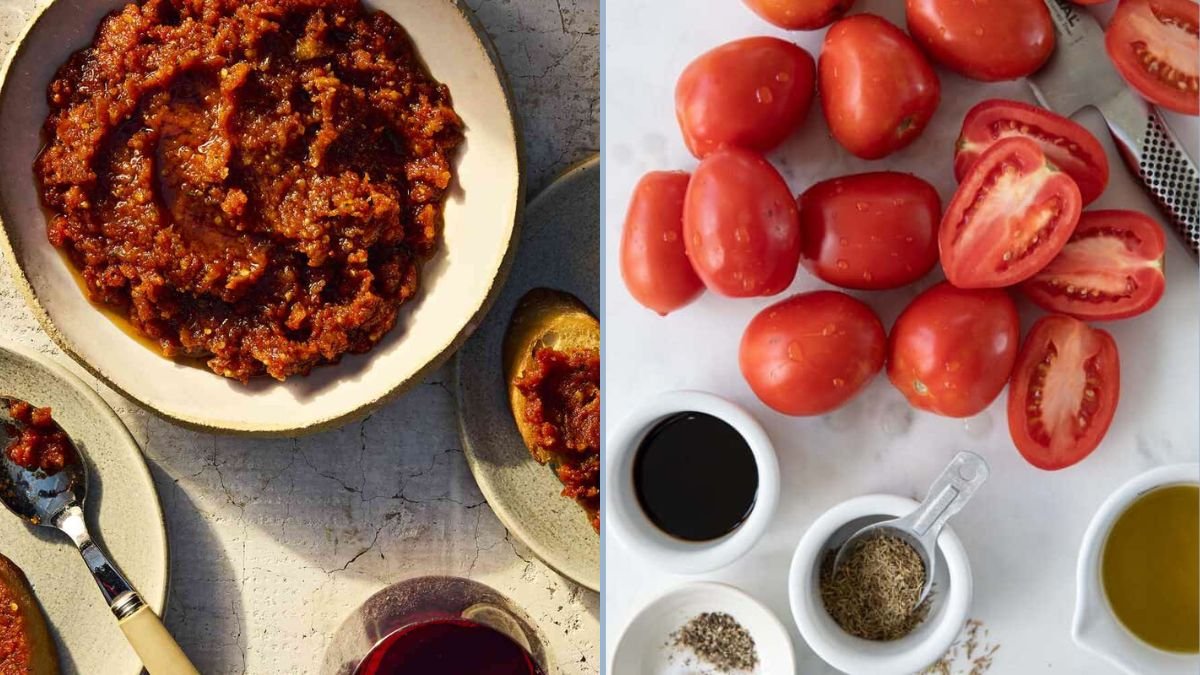Tomatoes are a cornerstone of vegetarian cooking, forming the base for sauces, soups, stews, and condiments. Fresh, ripe tomatoes are bursting with flavor, but their high water content makes them highly perishable. Drying tomatoes is an excellent preservation method that intensifies flavor, reduces spoilage, and allows year-round use in homemade sauces. Properly dried tomatoes maintain their vibrant color, natural sweetness, and nutritional value, including vitamins A and C, potassium, lycopene, and antioxidants.
This article provides comprehensive guidance on drying tomatoes for homemade sauces, covering selection, preparation, drying methods, storage, rehydration, and sustainable practices.
1. Selecting Tomatoes for Drying
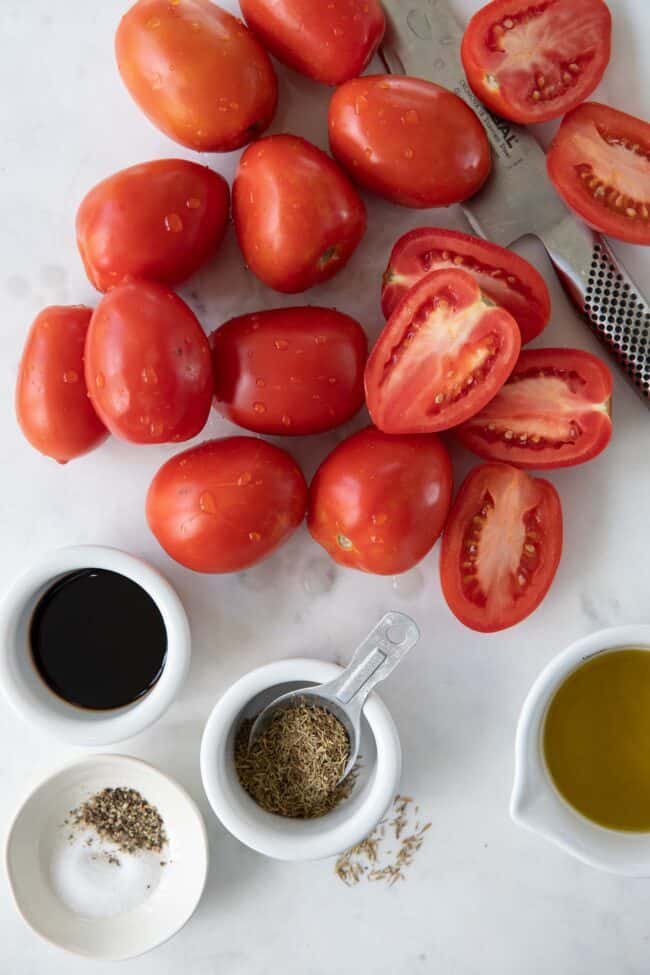
The first step in successful tomato drying is careful selection of quality produce.
Tips for Selection
- Ripeness: Choose fully ripe tomatoes for maximum flavor and sweetness. Overripe tomatoes can be used for sauces but may require longer drying times.
- Firmness: Firm tomatoes hold their shape better during drying.
- Variety: Roma or plum tomatoes are ideal due to their lower water content and meaty texture. Cherry tomatoes are also excellent for faster drying and concentrated flavor.
- Skin Integrity: Avoid tomatoes with cracks, bruises, or signs of rot.
High-quality tomatoes produce flavorful dried tomatoes and robust homemade sauces.
2. Preparing Tomatoes for Drying
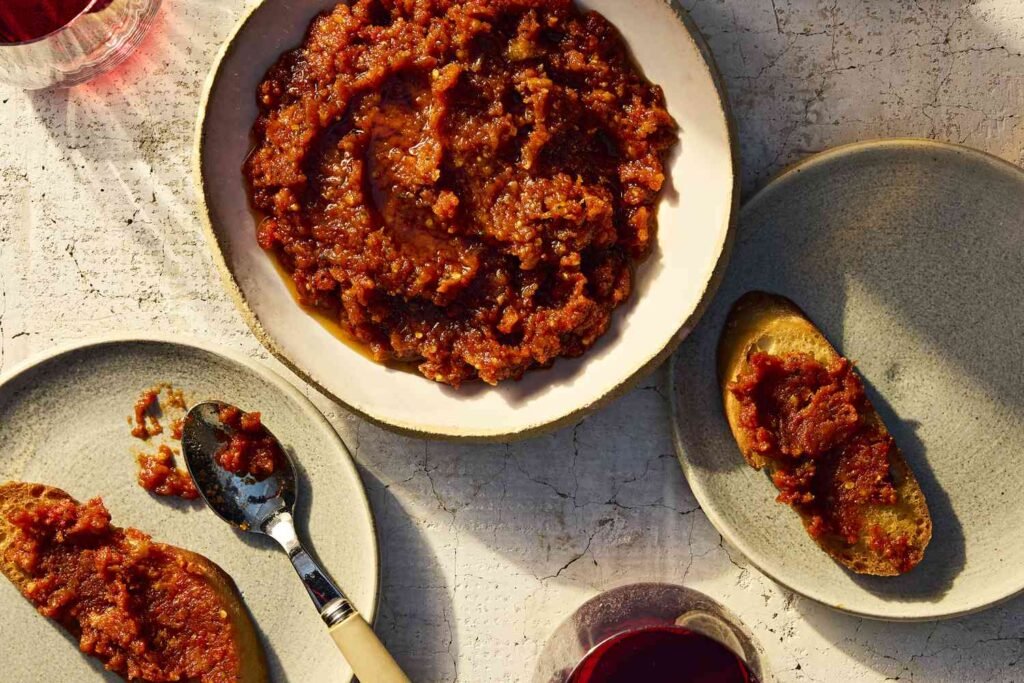
Proper preparation enhances drying efficiency and flavor retention.
Step 1: Washing
- Rinse tomatoes under cold water to remove dirt, pesticides, or debris.
- Pat dry thoroughly to prevent excess moisture that slows drying.
Step 2: Peeling (Optional)
- Removing skins is optional; it can reduce drying time and produce smoother sauces.
- To peel, blanch tomatoes briefly in boiling water for 30–60 seconds, then immerse in ice water before removing skins.
Step 3: Cutting
- Slice tomatoes uniformly, approximately ¼–½ inch thick, for even drying.
- Remove seeds if desired for smoother texture in sauces, though seeds can also be left intact for additional flavor.
Step 4: Optional Seasoning
- Lightly sprinkle with salt or herbs (such as basil, oregano, or thyme) to enhance flavor.
- Avoid adding oils before drying, as this can slow dehydration and encourage spoilage.
3. Drying Methods for Tomatoes
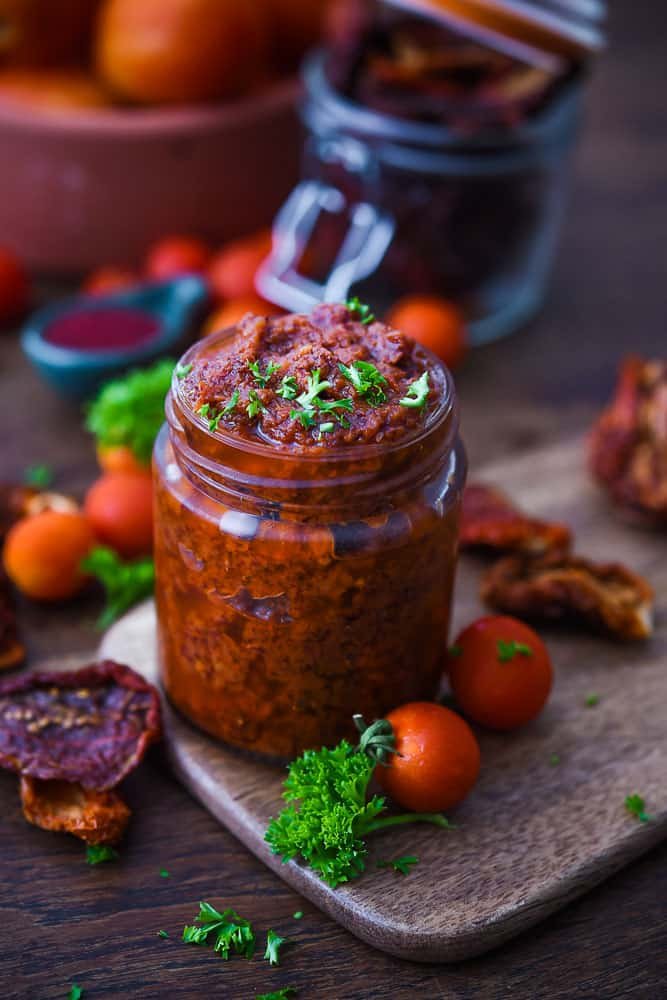
Several drying methods are suitable for homemade sauces, each with advantages.
A. Sun Drying
- Ideal in hot, dry climates with low humidity.
- Arrange tomato slices on a mesh or tray, avoiding overlap.
- Cover with a thin cloth to protect from insects.
- Turn slices periodically for even drying.
Pros: Energy-efficient and traditional.
Cons: Weather-dependent; requires several days.
B. Oven Drying
- Preheat oven to 50–60°C (120–140°F).
- Place tomato slices on a baking sheet lined with parchment paper.
- Dry 6–12 hours, turning occasionally.
- Check for leathery texture and moisture-free interior.
Pros: Controlled temperature and faster than sun drying.
Cons: Energy-intensive; may require monitoring.
C. Dehydrator Drying
- Place slices on dehydrator trays in a single layer.
- Set temperature to 50–60°C (120–140°F).
- Dry for 6–10 hours, depending on slice thickness and moisture content.
Pros: Efficient, consistent results; preserves color and nutrients.
Cons: Requires specialized equipment.
4. Determining When Tomatoes Are Properly Dried
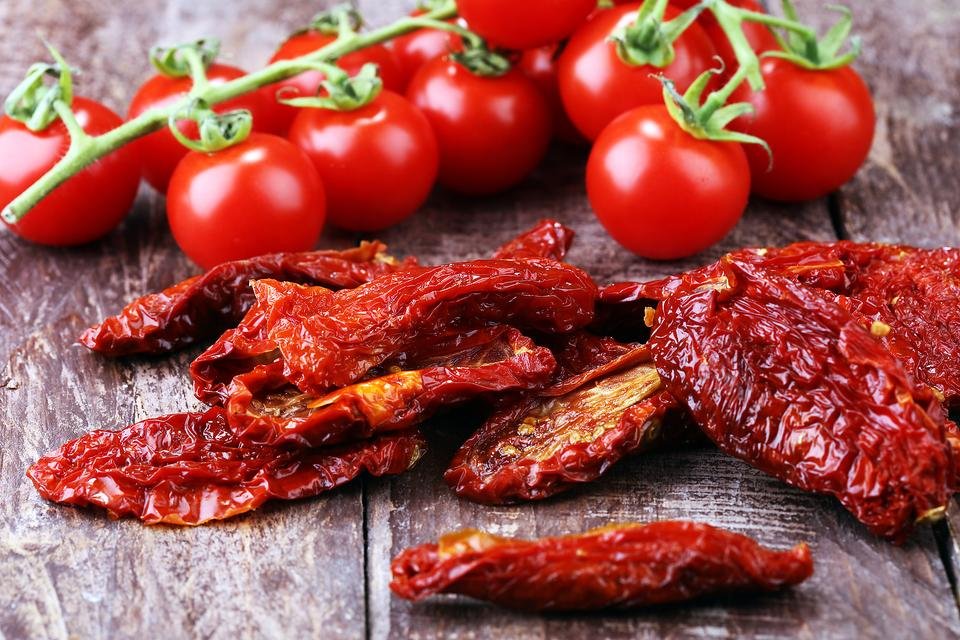
Properly dried tomatoes should have a leathery or slightly pliable texture, with no pockets of moisture. Over-drying can lead to hard, brittle tomatoes, while under-drying increases risk of mold during storage. Test by breaking a slice: it should bend without releasing water.
5. Storing Dried Tomatoes
Correct storage ensures longevity, color retention, and flavor.
Short-Term Storage
- Store in airtight glass jars or plastic containers in a cool, dark place.
- Dried tomatoes remain usable for 2–3 months at room temperature.
Long-Term Storage
- For longer shelf life, store in refrigerators or freezers in vacuum-sealed or airtight containers.
- Dried tomatoes can last up to 12 months when properly stored.
Adding Olive Oil
- For flavor enhancement and preservation, submerge dried tomatoes in olive oil.
- Keep refrigerated to prevent spoilage.
- Optional: Add herbs, garlic, or chili flakes for additional flavor.
6. Rehydrating Dried Tomatoes for Homemade Sauces
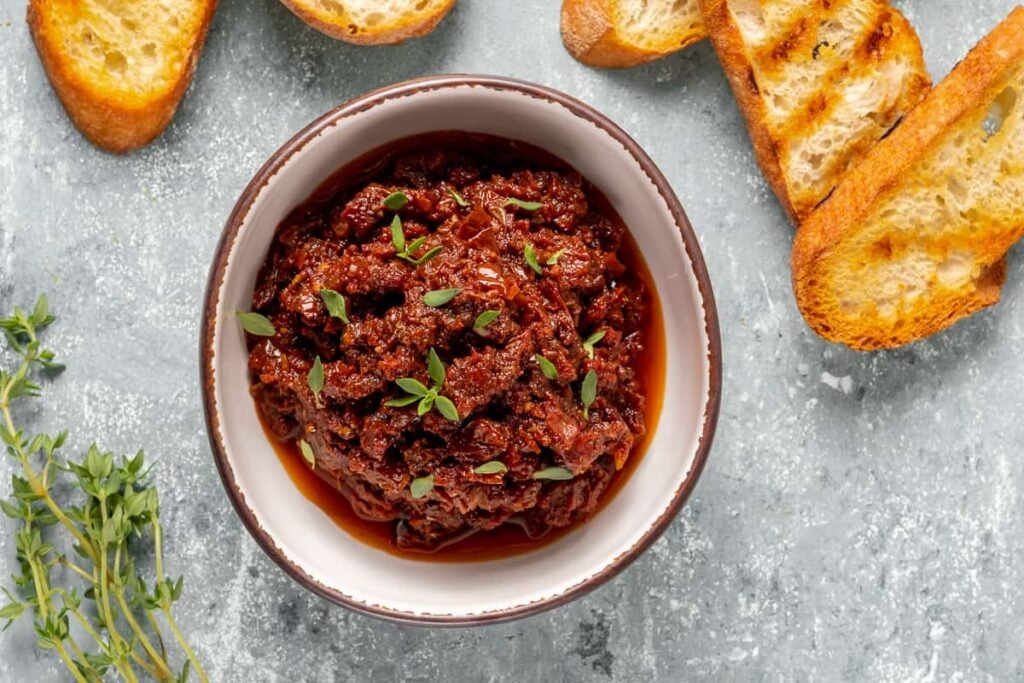
Before using in sauces, dried tomatoes are often rehydrated.
Rehydration Techniques
- Water Soak: Immerse in warm water for 20–30 minutes until soft. Drain and chop as needed.
- Direct Cooking: Add dried tomatoes directly to simmering sauces; they rehydrate while infusing flavor.
- Oil Soak: Soak in olive oil for a few hours to soften and infuse oil with flavor.
Tips
- Save soaking water to enhance sauce flavor.
- Rehydrated tomatoes retain intense flavor and contribute to richer, deeper-colored sauces.
7. Avoiding Common Drying Mistakes
Several mistakes can compromise the quality of dried tomatoes.
| Mistake | Effect | Solution |
|---|---|---|
| Slicing unevenly | Uneven drying; some pieces mold | Slice tomatoes uniformly |
| Drying at high temperatures | Loss of color, nutrients, and flavor | Dry at 50–60°C / 120–140°F |
| Storing with moisture | Mold growth | Ensure tomatoes are fully dry before storage |
| Using non-airtight containers | Oxidation and flavor loss | Use airtight glass or vacuum-sealed containers |
| Adding oil before drying | Slow dehydration and spoilage | Add oil only after drying if desired |
8. Nutrient Preservation in Dried Tomatoes
Tomatoes are rich in vitamins A, C, potassium, and lycopene, a powerful antioxidant. Drying concentrates flavors and nutrients while reducing water content.
Tips
- Dry promptly after harvest for maximum nutrient retention.
- Avoid prolonged exposure to sunlight after drying.
- Store in cool, dark environments to prevent degradation of color and antioxidants.
- Use rehydrated tomatoes in sauces shortly after soaking to preserve vitamins.
9. Culinary Uses of Dried Tomatoes in Sauces
Dried tomatoes add depth, sweetness, and natural umami to vegetarian sauces.
Ideas
- Classic Tomato Sauce: Rehydrate dried tomatoes and blend with garlic, onion, and herbs for pasta sauces.
- Soup Base: Add directly to vegetable soups for concentrated flavor.
- Pasta Sauces: Combine with olive oil, garlic, and herbs for a rich, rustic sauce.
- Pizza Toppings: Use rehydrated slices or oil-infused tomatoes for a burst of flavor.
- Condiments: Blend dried tomatoes with olive oil and spices for spreads and dips.
Properly dried tomatoes enhance both flavor and nutrition of homemade sauces.
10. Sustainable and Eco-Friendly Practices
Drying tomatoes at home supports sustainable kitchen practices.
Suggestions
- Use solar or dehydrator drying methods to save energy over commercial preservation.
- Compost any spoiled or rejected tomatoes.
- Store in reusable glass jars or vacuum-sealed containers to reduce plastic waste.
- Plan harvest and drying schedules to avoid excess waste and maximize productivity.
Sustainable practices preserve flavor while minimizing environmental impact.
Conclusion
Drying tomatoes for homemade sauces is an effective, natural, and space-efficient preservation method. Selecting firm, ripe tomatoes, preparing them properly, and using appropriate drying techniques—sun drying, oven drying, or dehydrator drying—ensures vibrant, flavorful, and nutrient-rich dried tomatoes. Proper storage in airtight containers or olive oil enhances shelf life, while careful rehydration brings out concentrated flavor for sauces.
By following these vegetarian-friendly methods and avoiding common mistakes, dried tomatoes can be enjoyed year-round in rich, delicious sauces that elevate a wide variety of dishes. Home drying also supports sustainable and eco-conscious kitchen practices, reducing food waste and allowing maximum utilization of seasonal harvests.
